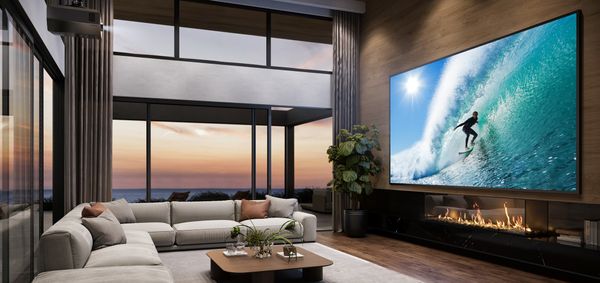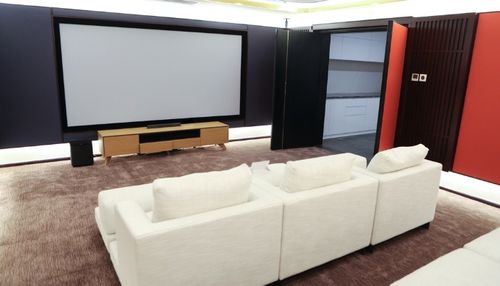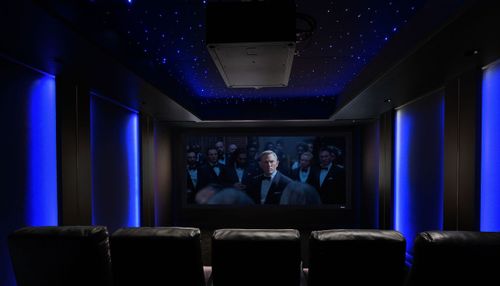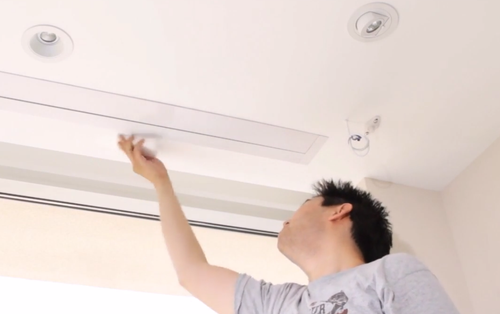
At a Glance:
Understanding Movie Projector Screen Fundamentals
The Science of Screen Size Selection
The Downsides of Oversized Home Theater Screens
Practical Installation Tips for Projector Screens
Why Trust Total Homes Technology?
Creating the perfect home theater experience starts with one crucial decision that can make or break your cinematic dreams: choosing the right movie projector screen size. Picture this scenario - you've invested thousands in a premium projector, surround sound system, and comfortable seating, only to realize your screen is either too small to create that immersive experience or too large for your space, causing eye strain and neck pain during movie nights.
The difference between a mediocre home theater and a breathtaking cinematic experience often comes down to getting the screen dimensions exactly right. When homeowners dive into home theater design Austin TX projects, they quickly discover that screen size isn't just about going as big as possible - it's about finding that sweet spot where technology, space, and human comfort intersect perfectly.
Expertly Built Home Theaters
From projector screens, projectors, seating, lighting, surround sound, and more, get expert installation by Total Home Technology for all your home theater needs.
Custom Home TheaterUnderstanding Movie Projector Screen Fundamentals

Every legendary home theater starts with understanding the science behind screen selection. Movie projector screen sizing isn't guesswork - it's based on decades of research into human visual perception and comfort. The diagonal measurement, similar to TVs, serves as the standard specification, but the real magic happens when you understand how screen dimensions interact with your specific space.
Home theater projector screens come in distinct categories that serve different purposes. Small screens (60-80 inches) work perfectly for intimate spaces like bedrooms or small apartments. Medium screens (100-120 inches) dominate residential installations, offering that cinematic feel without overwhelming typical living spaces. Large screens (130-150+ inches) create true theater experiences but require dedicated rooms with proper proportions.
The aspect ratio fundamentally changes your viewing experience. Traditional 16:9 screens match modern TV content perfectly, while 2.35:1 CinemaScope screens deliver that authentic widescreen movie theater experience. Understanding these ratios helps determine not just screen size, but the entire visual experience your space will deliver.
The Science of Screen Size Selection

How toc choose projector screen size involves understanding the relationship between human vision and screen dimensions. The human eye has a field of view of approximately 55 degrees horizontally, and the most comfortable viewing experience occurs when the screen occupies 30-40 degrees of that field.
Key considerations for screen size selection include:
- The industry-standard formula: Optimal viewing distance equals 1.5 to 2.5 times the screen width.
- Example: For a 100-inch 16:9 screen (87 inches wide), the ideal seating distance is 10.8 to 18 feet.
- Closer distances create immersive experiences, while farther distances reduce eye strain during long viewing sessions.
- Room acoustics:
- Larger screens need more powerful audio systems to maintain a proper sound-to-image balance.
- Acoustically transparent screens allow speakers to be placed behind the screen, ensuring audio aligns seamlessly with the visuals.
- Solid screens require careful speaker placement to avoid audio-visual disconnects.
Taking these factors into account will help you select the best movie projector screen size for an optimal viewing experience.
Learn more: The 8 Essential Components of Luxury Home Theaters
Room Dimensions: The Ultimate Limiting Factor
Your room dimensions are the first and most critical factor when determining projector screen sizes. Ceiling height often becomes the main constraint, as a screen should take up no more than 30% of the wall height. This ensures proper proportions and leaves space for speaker placement above or below the screen.
Key Considerations for Wall Width
- A screen's width is not the only factor—account for mounting hardware and acoustic treatments.
- Leave at least 12 inches of clearance on each side of the screen.
- For example, a 120-inch screen will require approximately 12 feet of wall width with clearances included.
Depth Requirements for Projectors
- Short-throw projectors: Ideal for smaller spaces, they create large images from minimal distances.
- Long-throw projectors: Require 15-20 feet of throw distance to produce a 120-inch image.
- Room depth is a critical constraint in home theater design Austin TX projects.
Pro Tips for Installation
Professional installers specializing in custom home theater installation Austin recommend:
- Measuring the room in three dimensions (height, width, and depth).
- Creating scale drawings before selecting a screen size.
This method helps avoid costly mistakes and ensures optimal sight lines from all seating positions.
Learn more: Austin's Top Home Automation Trends: What's Hot in Smart Home Tech
Seating Distance: The Comfort Zone
The relationship between seating distance and screen size directly affects viewer comfort and image quality. Sitting too close to a movie projector screen can reveal pixel structure, especially with lower-resolution content. On the other hand, sitting too far reduces the immersive experience that makes projection superior to traditional TVs.
Here are some key points to consider for seating distance:
- The front row should maintain a minimum comfortable distance of 1.5 times the screen width.
- The back row shouldn't exceed the maximum engagement distance of 2.5 times the screen width.
- Multi-row seating often determines the practical maximum screen size to ensure comfort for all viewers.
Additionally, neck angle comfort is crucial:
- Screens positioned too high create uncomfortable viewing angles.
- The center of the screen should align with the viewer's eye level when seated or slightly below for extended viewing sessions.
Resolution and Image Quality Considerations
Projector resolution significantly impacts the optimal best projector screen size, as higher resolution supports sharper images on larger screens.
Here’s how resolution affects screen size:
- 4K projectors maintain image sharpness even at larger screen sizes.
- 1080p projectors show limitations when pushed beyond 100-120 inches at typical home viewing distances.
Other factors to consider:
- Pixel density: 4K projectors deliver 8.8 million pixels, while 1080p provides 2.1 million. Larger screens spread these pixels, making individual pixels visible and degrading the experience.
- Content source quality: Streaming services often compress video, which can look worse on larger screens. High-quality Blu-rays maintain their quality better at larger sizes.
When choosing screen dimensions, think about your primary content sources. If you primarily watch compressed streaming content, a smaller screen might deliver better overall image quality.
Learn more: 3 Reasons to Add Retractable Privacy Screens to Your Outdoor Space
The Downsides of Oversized Home Theater Screens

Maximizing screen size may seem appealing, but oversized home theater projector screens can create several issues that harm the viewing experience rather than enhance it:
1. Increased Eye Fatigue
- Oversized screens force your eyes to constantly refocus across the large image area.
- This can lead to discomfort and strain, especially during extended viewing sessions.
2. Neck Strain from Head Movement
- Larger screens require viewers to move their heads to follow the action.
- This head movement can cause neck strain and lead to missed visual details in your peripheral vision.
- It’s particularly disruptive during fast-paced scenes, like action movies or sports.
3. Image Quality Degradation
- Bigger screens amplify flaws such as compression artifacts, noise, and resolution limitations.
- These issues, often unnoticed on appropriately-sized screens, become glaring on oversized displays.
- Older content or heavily compressed streams are especially affected.
Choosing the right screen size for your viewing distance is essential to achieving a comfortable and high-quality home theater experience.
Practical Installation Tips for Projector Screens

1. Proper Mounting and Positioning
- Critical for Performance: Correct mounting ensures optimal screen performance.
- Wall Support: Use wall studs to support the screen's weight and mounting hardware, especially for larger screens weighing 50+ pounds, including motorized mechanisms.
2. Manage Ambient Light
- Light Control is Key: Larger screens are more affected by ambient light issues.
- Solutions:
- Use light-rejecting screens to minimize the impact of room lighting.
- Install proper window treatments and plan your lighting design to control light effectively.
- Pro Tip: Dedicated theater rooms are ideal for oversized installations to reduce light interference.
3. Choose the Right Mounting Solution
- Fixed Screens:
- Offer excellent flatness and image quality.
- However, they lack flexibility for future adjustments.
- Motorized Screens:
- Provide flexibility to change screen size or aspect ratio.
- Keep in mind the potential for mechanical issues and higher costs.
Austin TX Market Insights
The Austin TX home theater company landscape offers unique advantages for homeowners pursuing projection systems. Total Home Technologies understands Texas home construction patterns, including common room dimensions and ceiling heights that influence screen size decisions.
Climate considerations specific to Austin affect installation choices. High humidity and temperature fluctuations require screens designed to handle environmental stress without warping or developing creases. Local installers experienced with projector screen installation Austin TX understand these regional factors and specify appropriate screen materials.
Ready to upgrade your home entertainment? Contact Total Home Technologies today for expert installation and tailored solutions!
Frequently Asked Questions
The 4-6-8 rule provides a quick guideline for movie projector screen size selection based on viewing distance. For every 4 feet of viewing distance, you can comfortably use a 6-foot wide screen (approximately 80-inch diagonal 16:9 screen), with 8 feet being the maximum comfortable distance. This translates to viewing distances of 1.5 to 2 times the screen width, ensuring optimal comfort and image quality.
Movie projector screen size selection depends on your room dimensions and seating distance. For typical home theaters, 100-120 inch screens work best. Calculate your ideal size using this formula: screen width = viewing distance ÷ 2. For example, if your couch sits 12 feet from the wall, a screen approximately 6 feet wide (100-inch diagonal 16:9) provides optimal viewing. Always verify your projector can produce your desired screen size at your available throw distance.
For a 120-inch movie projector screen (104-inch width in 16:9 format), optimal viewing distance ranges from 13 to 22 feet. The closest comfortable distance is 1.5 times the screen width (13 feet), while maximum engagement distance reaches 2.1 times the width (18 feet). Sitting closer than 13 feet may cause eye strain, while distances beyond 22 feet reduce the immersive advantage of projection over traditional TVs.
While basic fixed screens can be DIY projects, motorized screens and complex installations typically require professional expertise. Custom home theater installation Austin professionals ensure proper mounting, electrical connections, and integration with control systems. For screens over 100 inches or installations involving ceiling mounting, professional installation prevents costly mistakes and ensures optimal performance.
Why Trust Total Home Technologies
At Total Home Technologies, we are dedicated to turning your vision for a smart, connected home into reality. Specializing in the latest innovations in smart home automation, home theater design, advanced lighting control, motorized shades, outdoor entertainment, and more, we bring tailored solutions to enhance your lifestyle. Serving Austin, TX, and the surrounding areas, our experienced team combines cutting-edge technology with expert craftsmanship to deliver results that are both functional and stylish. Whether you're starting fresh with a new build or upgrading your current home, you can trust us to provide personalized guidance and solutions every step of the way. Together, we’ll create a home that perfectly balances sophistication, convenience, and comfort.
Shop Projector Screens at Total Home Technologies
Choosing Total Home Technologies for your custom home theaters in Austin, TX, means partnering with a local team that truly understands the unique needs of the community. Our expertise, combined with a deep commitment to customer satisfaction, ensures that every solution is tailored specifically to your lifestyle. With a focus on quality, innovation, and seamless integration, we make it easy for you to enhance your home with advanced technologies designed to add convenience, energy efficiency, and modern style to your everyday life. Let us make your smart home vision a reality.